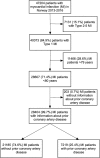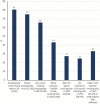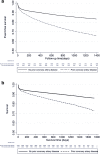Unsatisfactory risk factor control and high rate of new cardiovascular events in patients with myocardial infarction and prior coronary artery disease
- PMID: 30922234
- PMCID: PMC6437860
- DOI: 10.1186/s12872-019-1062-y
Unsatisfactory risk factor control and high rate of new cardiovascular events in patients with myocardial infarction and prior coronary artery disease
Abstract
Background: Patients with established coronary artery disease (CAD) have an increased risk of new cardiovascular events. An underuse of secondary preventive drugs has been observed, and many patients may not attain the treatment goals for secondary prevention. The aims of the present nationwide register-based cohort study were to assess the degree of risk factor control and long-term outcomes in patients < 80 years with Type 1 myocardial infarction (MI) with and without prior CAD.
Methods: Data concerning all patients with MI admitted to hospitals in Norway from 2013 to 2016 were retrieved from the Norwegian Myocardial Infarction Register (NORMI). Long-term mortality was obtained through linkage with the Norwegian Cause of Death Registry.
Results: In total, 47,204 patients were registered in the NORMI from 2013 to 2016. Prior CAD was recorded in 7219 (25.2%) of the 28,607 patients < 80 years old with Type 1 MIs. On average, 3 of the 6 defined treatment targets for secondary preventive therapy were attained, and only 1% of the patients achieved all targets. Patients with MI and prior CAD had increased risk of death or new MI compared to patients without prior CAD during long-term follow-up (adjusted HR 1.6, 95% CI 1.5-1.7).
Conclusions: Prior CAD was frequent in patients with acute MI. The attainment of secondary preventive treatment targets in patients with MI and prior CAD was not optimal, and the long-term outcomes were reduced compared to patients without prior CAD. Increased efforts to improve risk factor control are needed.
Keywords: Myocardial infarction; Risk factors; Secondary prevention.
Conflict of interest statement
Ethics approval and consent to participate
The Regional Committee for Medical and Health Research Ethics approved the study (REK 2016/170). No consent to participate was required.
Consent for publication
Not applicable.
Competing interests
The authors declare that they have no competing interests.
Publisher’s Note
Springer Nature remains neutral with regard to jurisdictional claims in published maps and institutional affiliations.
Figures




References
-
- Perk J, De Backer G, Gohlke H, Graham I, Reiner Z, Verschuren M, et al. European guidelines on cardiovascular disease prevention in clinical practice (version 2012). The fifth joint task force of the European Society of Cardiology and Other Societies on cardiovascular disease prevention in clinical practice (constituted by representatives of nine societies and by invited experts) Eur Heart J. 2012;33(13):1635–1701. doi: 10.1093/eurheartj/ehs092. - DOI - PubMed
-
- Roffi M, Patrono C, Collet JP, Mueller C, Valgimigli M, Andreotti F, et al. 2015 ESC guidelines for the management of acute coronary syndromes in patients presenting without persistent ST-segment elevation: task force for the Management of Acute Coronary Syndromes in patients presenting without persistent ST-segment elevation of the European Society of Cardiology (ESC) Eur Heart J. 2016;37(3):267–315. doi: 10.1093/eurheartj/ehv320. - DOI - PubMed
-
- Eckel RH, Jakicic JM, Ard JD, de Jesus JM, Houston Miller N, Hubbard VS, et al. 2013 AHA/ACC guideline on lifestyle management to reduce cardiovascular risk: a report of the American College of Cardiology/American Heart Association task force on practice guidelines. Circulation. 2014;129(25 Suppl 2):S76–S99. doi: 10.1161/01.cir.0000437740.48606.d1. - DOI - PubMed
Publication types
MeSH terms
Substances
LinkOut - more resources
Full Text Sources
Medical
Miscellaneous

